06 signs your offshore vendor is overbilling your agency
Outsourcing is nothing new to agencies. It has long been hailed as a strategic tool for businesses to reduce costs, streamline operations, and focus on their core competencies. However, beneath the many benefits, many offshore vendor overbilling risks often lurk unnoticed.
The gravity of the situation becomes startlingly clear when we peruse industry statistics.
Data shows that over 35% of businesses have overpaid in their outsourcing initiatives due to hidden fees and opaque billing processes.
An industry survey revealed that nearly 40% of agencies reported a mismatch between the promised expertise level and the resources deployed by outsourcing partners.
43% of agencies have lost trust in outsourcing due to overbilling, which erodes their confidence and leads to missed opportunities for cost savings.
Such overbilling practices prevent agencies from fully capitalizing on the potential benefits of outsourcing, hindering their ability to reduce expenses effectively. So, how can your agency rise above these disturbing trends and avoid falling into the same overbilling trap?
Just as you would need a magnifying glass to spot those tiny critters, detecting overbilling requires a sharp eye and a deeper understanding of where and how these issues can arise.
This blog delves into these pressing concerns, highlighting seven red flags and providing actionable solutions. We aim to equip you with strategies to navigate the outsourcing cost maze, ensuring a transparent, fair, and control-oriented outsourcing experience.
“It’s crucial to be proactive and observant of any red flags of overbilling in your outsourcing partnerships. An informed eye on sudden cost spikes, resource discrepancies, or opaque billing processes can be the difference between a profitable project and a costly misstep.” – Varun Bihani, Founder @TogetherWeShip
Warning signs of overbilling in outsourcing
Navigating the complex landscape of outsourcing can be challenging. This section identifies seven critical red flags that could indicate potential overbilling in outsourcing arrangements. Accompanied by a comprehensive doughnut chart, these red flags range from hidden fees to vague acceptance criteria, contributing to inflated outsourcing costs. With awareness and understanding of these red flags, organizations can mitigate risks and ensure fair and transparent outsourcing practices.
Allocation of overbilling risks in outsourcing
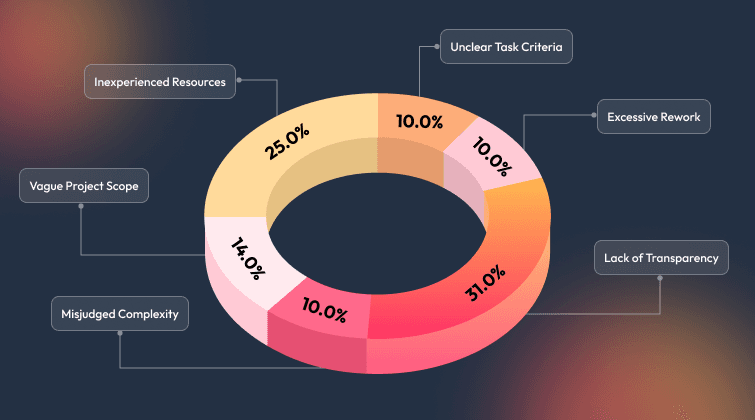
Non-transparent billing processes
When there is a lack of clear and detailed breakdowns of the services rendered, it becomes challenging for businesses to verify the accuracy of charges. Transparency ensures that clients understand what they are paying for and can track costs effectively. Without transparent billing processes, businesses may find themselves in a position where they are unable to reconcile invoices with the actual work performed, making it difficult to identify potential discrepancies and address them promptly.
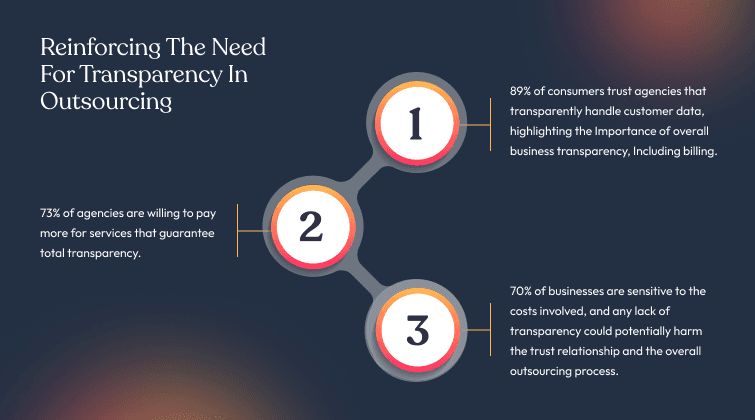
Deploying juniors over seniors
The utilization of inexperienced junior resources in place of senior professionals, mainly when the associated cost does not reflect the required level of expertise, serves as a clear indication of potential overbilling. This disparity in resource allocation not only jeopardizes the quality of deliverables but also heightens the risk of inflated charges. Junior resources may lack the requisite skills and experience to effectively handle complex tasks, leading to prolonged project timelines, additional revisions, and, ultimately, escalated expenses.
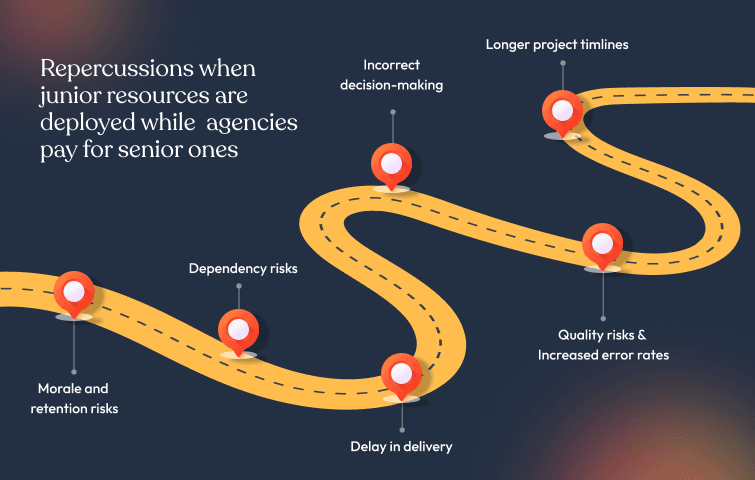
Unclear scope in large projects
Unclear project scopes pose a significant risk of overbilling in outsourcing, particularly in large-scale projects. When the scope is ambiguous or poorly defined, estimating costs accurately and allocating resources effectively becomes challenging. Lack of clarity can lead to misunderstandings and misalignment between the client’s expectations and the outsourcing provider’s deliverables. As a result, additional work or revisions may be required, which can be invoiced separately, leading to unexpected costs and potential overbilling.
Undefined task completion criteria
Acceptance criteria define when a task is considered complete. When acceptance criteria are incomplete or vague, measuring and assessing the deliverables becomes challenging. This ambiguity can lead to disputes between the client and the outsourcing provider over whether a task or milestone has been successfully completed, potentially resulting in additional charges.
Frequent rework due to poor quality
An alarming issue that often arises in outsourcing projects is the need for frequent rework due to subpar quality. When the outsourcing provider fails to deliver work that meets the expected quality standards, clients may be forced to request revisions or redo entire tasks, resulting in additional charges. Frequent rework leads to delays and increased project timelines and significantly inflates project costs.
Initial Project Delivery → Quality Issues Identified → Rework Requested → Delays and Increased Costs → Cycle Repeats
Poor grasp of work complexity
When the outsourcing provider lacks a comprehensive understanding of the complexity of the work involved, it can result in underestimation of effort and subsequent overbilling, which involves inaccurate cost estimates, resource misallocation, and potential project delays. Without a thorough understanding of the project intricacies, tasks may be overlooked or underestimated, requiring additional charges for unforeseen challenges and resource allocation.
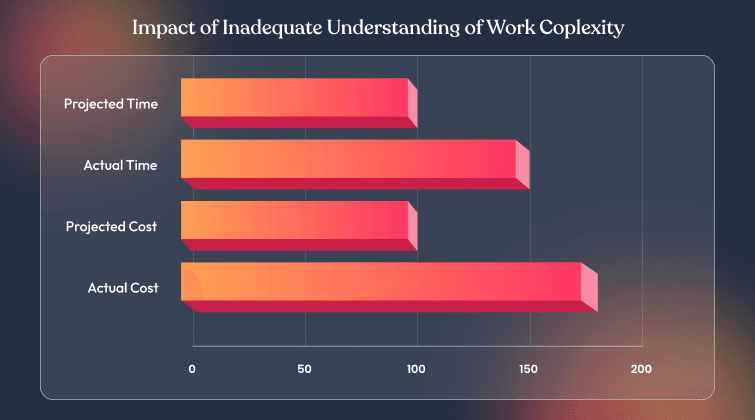
This represents the actual time to complete the project was 50% longer than projected, and the actual cost was 80% higher than projected due to inadequate understanding of the work complexity.
The impact of each warning sign on outsourcing costs
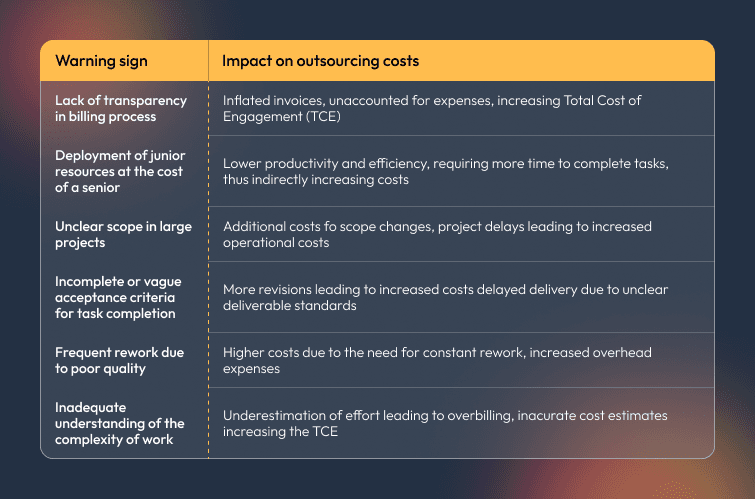
Why are your project costs higher than estimated?
The phrase “Why Your Project Cost Estimates Are Higher than Estimates” often rings true due to a variety of factors. These may include misconceptions about the complexity of the task, overlooked elements in the project scope, and unanticipated changes that arise during execution. In the following section, “Common Misconceptions about Cost Estimation,” we will delve deeper into these misconceptions and offer insights to foster better understanding and more accurate project cost forecasting.
Common misconceptions about cost estimation

Practical strategies to improve cost estimation
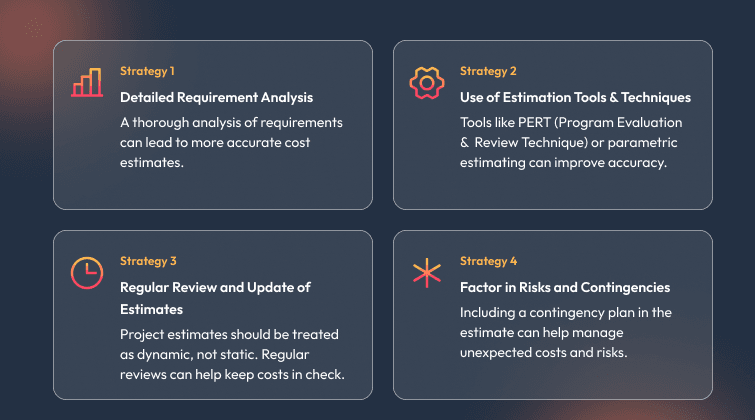
Six actionable tips to prevent being overbilled
01- Establish a transparent billing process
Promote transparency by requesting clear cost estimates, detailed hourly reports, and regular updates on resource usage. This not only helps you understand where your money is going but also enables you to track the project’s progress effectively.
02- Regularly monitor deployed resources
Implement mechanisms for regular communication and updates, such as daily standups, weekly progress reports, and monthly reviews. This allows you to stay abreast of the work being done and the resources deployed, reducing the risk of overbilling.
03- Define a clear project scope
A well-defined project scope sets clear expectations and objectives, ensuring that all parties are on the same page. This minimizes the chances of scope creep, which can lead to unexpected costs and delays.
04- Set concrete task completion parameters
Clearly define what constitutes ‘completion’ for every task. This reduces the chances of misunderstandings and misinterpretations, and helps to prevent overbilling based on incorrect or inflated effort estimations.
05- Ensure quality control measures
Ask your outsourcing partner to implement robust quality control measures. This minimizes the chances of rework, which can inflate project costs. Quality checks at every stage of the project can significantly reduce errors and save costs in the long run.
06- Prioritize comprehensive understanding of project complexity
Make sure your outsourcing partner has a thorough understanding of the project’s complexity and intricacies. This ensures accurate cost estimation and resource allocation and helps prevent overbilling due to unforeseen challenges or overlooked tasks.
Checklist for choosing your offshore partner
✔️Quality Standards
Recent evaluations of quality at the partner’s premises
Alignment between your organization’s quality expectations and the offshore partner’s standards
✔️Technological Capabilities
Evidence of advanced telecommunication facilities and tech infrastructure
Proven ability for quick and seamless data migration
✔️Operational Maturity and Stability
Clear commitment to standardized processes, methodologies, and performance metrics
Demonstrated consistency in project delivery, from meeting deadlines to staying within budget
Proven flexibility to scale and reassign resources as per project requirements
✔️Security Measures
Well-documented contingency plans for emergencies
Proven risk mitigation strategies
Capability to distribute work efficiently across local facilities
✔️Motivational Aspects
Commitment to providing long-term competitive advantages
Availability of long-standing customer relationship testimonials
Investment in employee training and retention programs
✔️Leadership Qualities
Demonstrated proficiency in managing distributed teams
Display of individual-level project management certifications
Utilization of effective engagement management tools
Connect, collaborate, and conquer with togetherweship
Outsourcing can be risky, no matter how much attention you pay. That’s why we are here to help you out! With transparent billing, expert resources, clear scope, and no hidden fees, TogetherWeShip tackles overbilling risks effectively. Choose us to minimize overbilling and make outsourcing a success!
Choose TogetherWeShip – For Fair, Transparent, and Value-Driven Outsourcing!
Test-drive us. Pay only if you love our work.